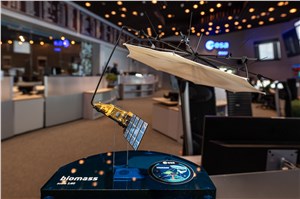
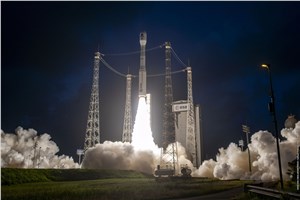
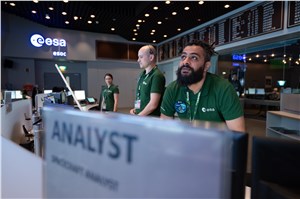
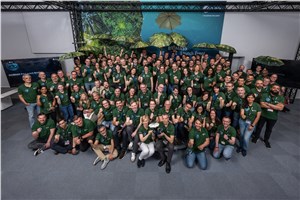
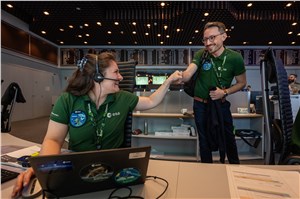
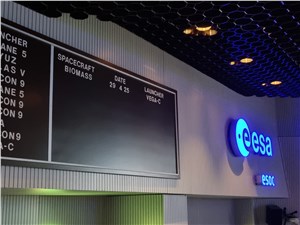
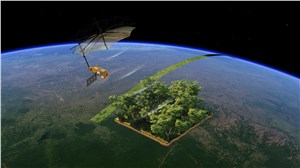
Mission control at ESA’s European Space Operations Centre has completed the critical Launch and Early Orbit Phase (LEOP) for ESA’s Biomass, after nine days of intense work.
Making a satellite ready for life in orbit can feel like a sprint or a marathon. But Biomass? Deploying ESA’s latest Earth Explorer mission was a nine-day-long relay race in Earth orbit, where every baton pass had to be perfect.
From the final countdown last week to the unveiling of the satellite’s big antenna earlier this week, Biomass’ journey through Launch and Early Orbit Phase (LEOP) was a remarkable combination of precision, endurance, and teamwork.

Market forecasts by Region and Platform Type. Country Analysis, Market and Technology Overview including Critical Raw Materials, Opportunity Analysis, and Leading Company Profiles
Download free sample pagesFirst leg: Getting the signal
Months of preparation culminated in a flawless liftoff. On 29 April, at 11:15 CEST, Biomass launched as scheduled. At 12:13 UTC, the satellite separated from the launcher, marking the moment when the control baton was passed from the launch provider to the mission control team at ESA’s European Space Operations Centre (ESOC).
Like runners at the starting line, they took off at once.
At 12:27 UTC, the satellite’s first signal was acquired over Troll station, in Antarctica, confirming it had made it safely to orbit. Soon after, mission operators received confirmation that the solar array had successfully deployed. Power was flowing.
From this moment, the flight dynamics team started calculating the satellite’s initial orbit and planning its transfer to the final operational trajectory. The 9-day race had truly begun.
Second leg: Making the satellite ready for orbit
The first four days of LEOP followed a familiar pattern: stabilising the spacecraft, verifying critical subsystems, checking latch valves, and preparing for what would become one of the most delicate deployments in ESA mission history.
What made this LEOP stand out was its length. While a satellite usually takes between three to four days to get ready for life in Earth orbit, the Biomass team took an exceptional nine days to deploy the satellite and its 12-metre-diameter antenna.
To meet this challenge, the operations team reorganised into three daily shifts: two 8-hour frontline shifts for operations, and a night shift dedicated solely to monitoring.
“It was a marathon schedule, but one that gave the reflector deployment the care it demanded,” said Elia Maestroni, Biomass Spacecraft Operations Manager. “Our team had rehearsed these nine days for over four months and was ready to meet the challenge.”
Third leg: Deploying the antenna
With the satellite confirmed healthy and the ground segment fully commissioned, the next part of the race began: deploying the reflector, a five-day operation requiring precision, patience, and steady nerves.
During the first three days, mission control deployed the 7.5-metre-long supporting boom on which the reflector stands. Each day, the team deployed one of the boom’s three sections. This careful pacing wasn’t about slowness, it was about safety, as the operation required the simultaneous coverage of two ground stations.

Biomass antenna deployment selfie (CREDIT: ESA)
Once the boom got fully assembled, the team turned on the satellite’s monitoring camera – aimed at the reflector – and got ready for the show: the deployment of the antenna’s reflector.
This part of the deployment required the coverage from three overlapping stations. Due to orbit dynamics, there was only two viable deployment slot per day: a 24-minute window. The deployment command was sent, and the team held its breath as the confirmation would only come during the next pass. 37 minutes later, confirmation came: the antenna had deployed correctly!
Navigating the space debris risk
During boom deployment and reflector unfolding, Biomass entered a period of limited manoeuvrability - a fact that raised the stakes considerably. At 666 km altitude, the orbital lanes are busy with space debris, and it is important to be constantly on the lookout for potential collisions.
For three days during boom deployment and again during reflector release, the satellite could not perform collision avoidance manoeuvres. Although no debris came close, the idea of not having the option to move placed enormous importance on the work performed by the ESA’s Space Debris Office and its collision avoidance predictive tools, which are used to project the satellite’s path with regards to debris.
"Due to its specific shape, it is expected that Biomass has to perform four to five avoidance manoeuvres per year under the current traffic environment. This results in roughly one alert per week, which is more than for many other spacecraft in this orbital regime,” says Klaus Merz, ESA Space Debris Analyst.
Final leg: Putting the last touches and celebrating
With the reflector deployed, the team could breathe again. The last day was reserved for the final preparations. Biomass’ GNSS receiver was activated to acquire precise orbit position and to synchronise onboard time with global navigation signals -another baton passed smoothly.
As the Biomass team assembled inside ESA's Main Control Room for the traditional ceremony during which the mission’s name is added to the wall, Biomass Flight Operations Director José Morales noted: “All operations have been executed on time and on schedule, the satellite and ground systems are performing flawlessly. Congratulations to everyone in the team for this efficient and reliable teamwork”.
Ready for the next race
The LEOP might have ended but the baton has been passed once more - this time to the teams responsible for payload commissioning and calibration of the instruments.
Biomass has already entered its six-month commissioning phase, which will include flyovers of a custom-built transponder located in New Norcia, Australia. This ‘Biomass Calibration Transponder’ will help calibrate the spacecraft’s P-band radar, which is key to deliver crucial information about the state of our forests.
After commissioning, Biomass will continue to return to New Norcia for calibration up to twice a year, ensuring long-term accuracy of its groundbreaking instrument.